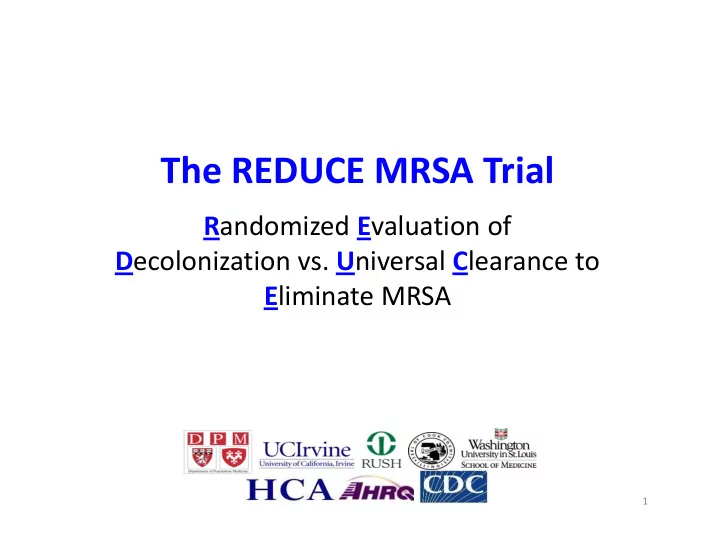

The REDUCE MRSA Trial R andomized E valuation of D ecolonization vs. U niversal C learance to E liminate MRSA 1
Trial Rationale • MRSA important in healthcare associated infections • Many quality improvement strategies – Screen and isolate – Screen, isolate, decolonize – Universal decolonization • No head ‐ to ‐ head comparisons • Debate of high risk pathogen vs high risk populations 2
• Hospital Corporation of America • Harvard Pilgrim Healthcare Institute/Harvard Medical School • University of California Irvine • Rush University • CDC Prevention Epicenters Steering Committee Huang SS et al. NEJM Jun 2013:368:2255 ‐ 2265
Cluster Randomized Trial Randomized hospitals and all their adult ICUs to: • Arm 1: Routine Care – Screened all patients; isolated known MRSA+ • Arm 2: Targeted Decolonization – Screened all patients; isolated if known MRSA+ – Decolonized if MRSA+ • Arm 3: Universal Decolonization – No screening; isolated if known MRSA+ – Decolonized all
Decolonization in Community ICUs • 74 adult ICUs • 43 hospitals, 16 states o 1 academic center, 42 community hospitals o 3 ‐ arm cluster randomized trial of hospitals Baseline Phase Intervention 12 month In 18 month Jan 2010 Apr 2010 Sep 2011 5
Decolonization Regimens • Arm 2: Targeted Decolonization – Nasal mupirocin twice daily for 5 days – Chlorhexidine baths daily for 5 days • Arm 3: Universal Decolonization – Nasal mupirocin twice daily for 5 days – Chlorhexidine baths daily for ICU duration
Outcomes • Primary – Any MRSA clinical isolate attributed to ICU • Secondary – MRSA bloodstream isolate attributed to ICU – Any bloodstream isolate attributed to ICU • Outcome Definitions – Microbiology results alone – > 2d after ICU admit � 2d after ICU discharge
Intervention Period Intervention: 74,256 patients 282,803 ICU patient days Arm 1 Arm 2 Arm 3 As Randomized 16 Hospitals 13 Hospitals 14 Hospitals (23 ICUs) (29 ICUs) (22 ICUs) N = 23,480 N = 26,024 N = 24,752 1 Hospital (2 ICUs) withdraws As Treated 16 Hospitals 13 Hospitals 13 Hospitals N = 22,105 N = 23,480 N = 26,024 8
Select Population Characteristics No important differences between Baseline, Intervention Periods 9
MRSA Clinical Cultures Overall P=0.01 Arm 2 vs 1 P=0.09 Arm 3 vs 1 P<0.003 Arm 3 vs 2 P=0.16 Arm 1 Arm 2 Arm 3 Routine Targeted Universal 10
MRSA Bloodstream Infection Overall P=0.11 Arm 1 Arm 2 Arm 3 Routine Targeted Universal 11
All Pathogen Bloodstream Infection Overall P<0.0001 Arm 2 vs 1 P=0.04 Arm 3 vs 1 P<0.0001 Arm 3 vs 2 P=0.003 Arm 1 Arm 2 Arm 3 Routine Targeted Universal 12
BSI Reduction by Pathogen Type Elevated baseline bloodstream rate in Arm 3 maybe related to higher acuity. Arm 3 had 2 of 3 BMT units in the trial, and 3 of 4 solid organ transplant units.
Protocol Compliance • Compliance monitoring – Once a week point prevalence checks – Quarterly direct observation of bathing with checklist Arm 1 Arm 2 Arm 3 (among MRSA+) Screening 98% 99% 1% CHG bathing < 1% 89% 81% Mupirocin < 1% 91% 86% • Reasons for non ‐ compliance – < 1 day stay, discharge before scheduled activity, decline, moribund
Implementation – Key Features • Usual quality improvement personnel • No on ‐ site investigators • Rapid response email/phone • Bi ‐ weekly coaching calls • Educational material provided – Protocols – Binders – Computer based training modules – FAQs – Bathing video, podcast • Site visits for bathing training and as requested • CDC Prevention Epicenters Steering Committee
Electronic Solutions • Electronic nursing queries for compliance • Coaching calls – Attendance tracked – Presentations recorded and posted • Educational materials – Computer based training module and tracking – Bathing video – Podcast • Analytic datasets – Descriptive variables and adjustors – Outcomes
Education Materials 17
Challenges and Lessons Learned • State legislation – 5 hospitals randomized separately to only Arms 1 or 2 – Sensitivity analysis • Coaching call structure and accountability – Roll call – Required questions each call • Compatibility issues • Tracking competing interventions – 69 interventions proposed – 36 not pursued due to trial conflict
REDUCE MRSA Trial Summary • Effective pragmatic trial – Trial cost: $40/patient • Universal decolonization: CHG and mupirocin – Reduces MRSA and all BSI – Saves effort and cost of screening – May reduce need for contact precautions – Minimal adverse events • Horizontal vs Vertical Approaches – Universal better than targeted
Evidence Summary N Engl J Med 2013 368:2255-2265
Questions ? 21
Decision for Universal Mupirocin • Pro – S. aureus #1 HAI 1 – Screening not comprehensive 2 – Decolonization: CHG alone less effective than combination 2 – Highly effective in REDUCE MRSA trial vs proactive control – Will not lose systemic agent – Alternatives in pipeline • Con – Potential for resistance – Requires risk:benefit 1 Sievert et al. ICHE 2013;34(1):1 ‐ 14 2 Harbarth et al. AACT 1999;43(6):1412 ‐ 6
Recommend
More recommend